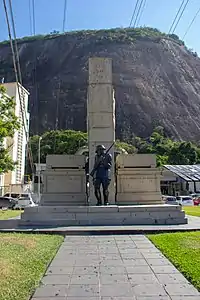Communist uprising of 1935
The Communist uprising of 1935 (Portuguese: Intentona Comunista) was a military revolt by leftist low-rank military against Getúlio Vargas's government, in the name of the National Liberation Alliance and with the support of the Brazilian Communist Party, which was back then called the Communist Party of Brazil, the uprising also had the support of the Comintern.[1] It was the last of a series of Brazilian military uprisings which began on 1922 under the name of tenentismo or the lieutenants revolts.[2][3] Later, Vargas used it as a pretext for the Estado Novo establishment.
| Communist uprising of 1935 | |||||||
|---|---|---|---|---|---|---|---|
 | |||||||
| |||||||
| Belligerents | |||||||
|
Supported by: Communist International | |||||||
| Commanders and leaders | |||||||
|
|
| ||||||
| Casualties and losses | |||||||
| At least 30 dead | At least 120 dead | ||||||
In 1932, the fascist Brazilian Integralist Action party was created. Later, in March 1935, an organization called the National Liberation Alliance (Portuguese: Aliança Nacional Libertadora - ANL) was created in Brazil, inspired by some popular fronts that emerged in Europe to prevent Nazi-fascist political advance. It argued for nationalist proposals and had as one of its objects to struggle for land reform. Led by nationalists and leftists, it managed to bring together the various sectors of society and quickly became a mass movement. Many military, Catholics, socialists and liberals, most of them disillusioned with the direction of the political process started in 1930, when Getúlio Vargas assumed the presidency of the Republic, joined the movement. Luís Carlos Prestes was chosen as its honorary president due to his prestige, in the left in general, particular with communists and some military while leading revolts during 1920s.
Despite the Brazilian Communist Party being declared illegal once again in August 1927, it quickly became the most prominent leftist organization in the country, establishing branches in many different cities and with thousands of supporters. In July 1935, just months after its creation, the ANL was declared illegal by Getúlio Vargas. Although the difficulty of mobilization had increased, the ANL still continued organizing rallies and demonstrations and reporting news critical of the government. In August, the organization stepped up preparations for an armed movement aiming at the overthrow of Vargas from power and the installation of a Communist regime headed by Luís Carlos Prestes. The plan was to start military uprisings in several regions with the support of the working class, which would trigger strikes across the country.
The first military uprising broke out on November 23, 1935, in Natal. The next day, another military uprising took place in Recife. On the 27th, a revolt broke out in Rio de Janeiro, then capital of the country. Without the support of the working class, and restricted to the three cities, the rebellion was quickly and violently put down. From then on, intense persecution affected not only communists, but also all government opponents. Thousands of people were arrested across the country, including congressmen, senators and even the mayor of Rio de Janeiro, Pedro Ernesto Baptista.
Despite its failure, the Communist revolt had provided a justification or pretext for assigning more power to Getúlio Vargas. After November 1935, the Congress approved a series of laws that restricted its own power, while the executive gained almost unlimited powers of repression. This process culminated in the coup of November 10, 1937, which closed the Congress, canceled the upcoming 1938 presidential elections and made Getúlio Vargas rule as a dictator. This period of Vargas dictatorship is called the Estado Novo, which lasted until 1945.
Gallery
.jpg.webp) Loyalist troops prepare for street fighting.
Loyalist troops prepare for street fighting. 3rd Infantry Regiment on fire after Communist attack.
3rd Infantry Regiment on fire after Communist attack. Interior of the Barracks of the 3rd Infantry Regiment, focus of the communist movement of November 1935.
Interior of the Barracks of the 3rd Infantry Regiment, focus of the communist movement of November 1935..jpg.webp) Rio de Janeiro Police Corps making barricades next seat of government.
Rio de Janeiro Police Corps making barricades next seat of government. Brazilian Marines coming to contain advancing Communist troops.
Brazilian Marines coming to contain advancing Communist troops. Communist civilians and rebel soldiers stand guard near the captured aircraft.
Communist civilians and rebel soldiers stand guard near the captured aircraft.
See also
References
- "A revolta comunista de 1935" (in Portuguese). Retrieved 2015-11-02.
- "A ANL e o Levante de 1935 – Entrevista com Marly Vianna" (in Portuguese). Archived from the original on 2015-12-22. Retrieved 2015-11-02.
- "As rebeliões de novembro de 1935" (PDF) (in Portuguese). Retrieved 2015-11-02.